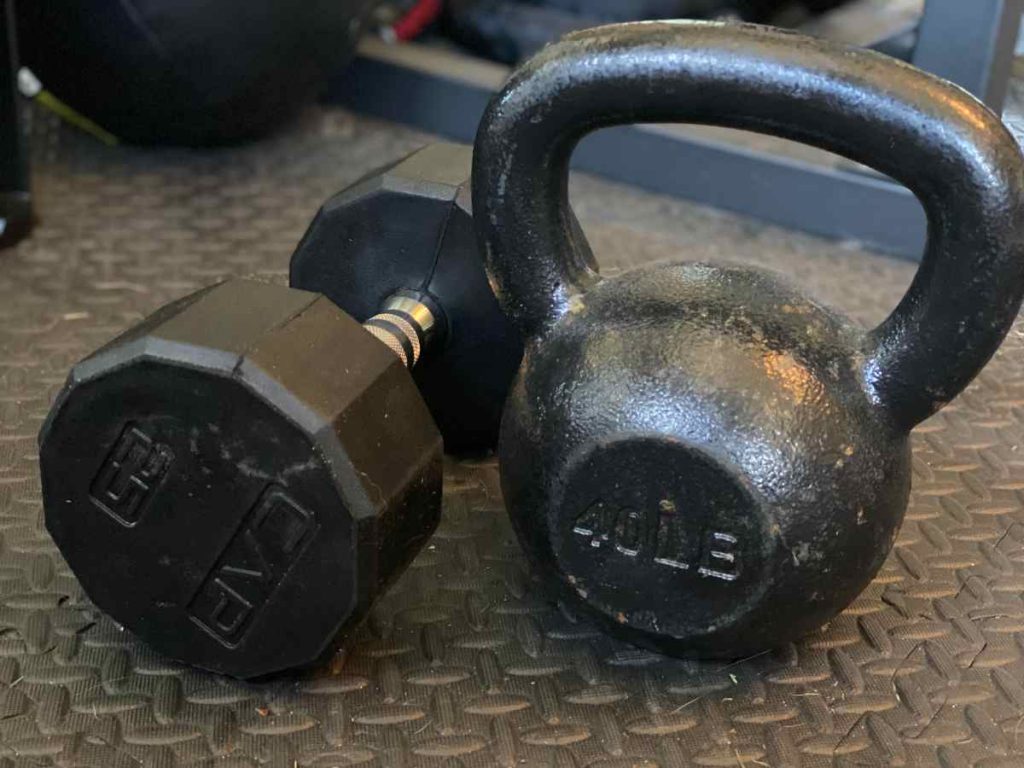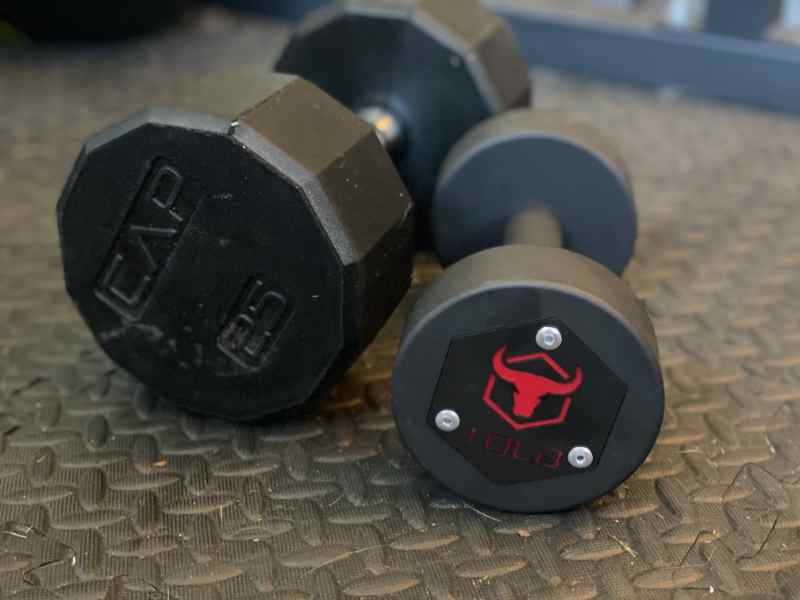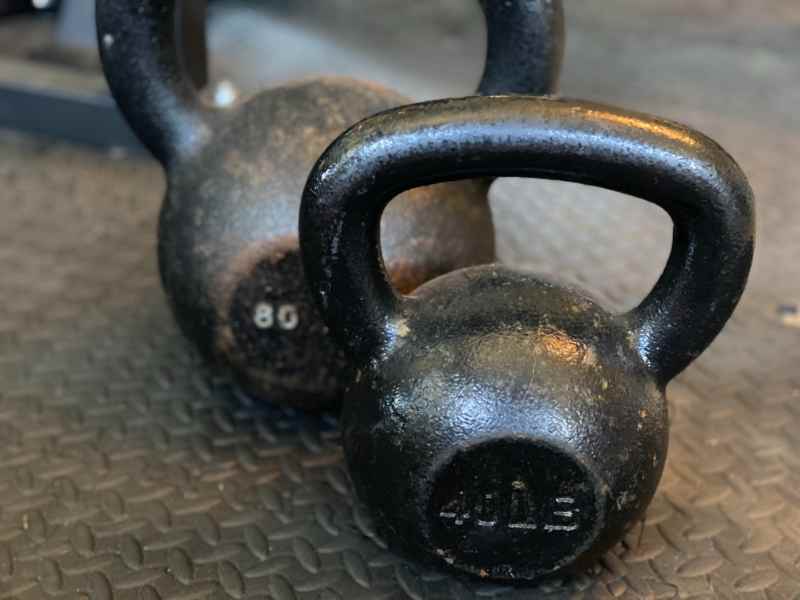Kettlebells and dumbbells are two of the most popular tools for resistance training. But which is best for you? In this guide, we’ll look at the key differences between kettlebells and dumbbells so you can choose the right tool for your training.

For as long as there have been gyms and BroScience, dumbbells have been a staple in Western gyms.
You can walk into any fitness center around the country and find a broad section of dumbbells.
But over the past few decades, the kettlebell has been making waves and growing more popular around North America and Europe.
In fact, some might argue that thanks to the advent of modern training methodologies like CrossFit and Tabata, they have become even more popular than the tried-and-proven dumbbell.
So which is actually better?
That’s what we’ve set out to analyze in this article.
In this article, we’ll walk you through the basics of kettlebells and dumbbells, looking at what makes them similar and the key differences between them.
We’ll look at the pros and cons of each and answer the most frequently asked questions about kettlebells so you can know for sure which is worth your time and money for the best workout possible!
To the bells!
Dumbbells – Overview
Dumbbells are weights designed for one-handed use. The weight is evenly distributed on both ends of the handle, so it remains balanced when you lift it.
Typically, dumbbells are used for one-handed variations on the standard two-handed exercises, replacing the barbell, which is a great way to increase core activation and balance out muscle imbalances.
Single arm dumbbell bench is my favorite example.

Others include a one-handed overhead press vs. the standard military press, flys vs. bench presses, isolation curls vs. barbell curls, and the list goes on.
Dumbbells come in a variety of shapes and materials, with urethane dumbbells (the kind of dumbbells seen in most commercial gyms), rubber hex dumbbells, neoprene dumbbells, and the all-in-one solution, adjustable dumbbells.
Dumbbells allow for a wide variety of grip options, from overhand, underhand, and neutral, making it an excellent form of resistance for people with limited shoulder mobility or elbows that are prone to tweaks.
Kettlebells – Overview
One look at kettlebells, and you can see how they’re different from dumbbells.
Rather than being designed with evenly balanced weights on either side of a handle, they’re designed with the weight sitting below the handle so that when you lift it, the weight hangs down.
The handles are also designed for one- and two-handed grip, allowing you to work one or both arms at the same time.

Kettlebells typically come in two shapes, with your “standard” kettlebell that has progressively thicker handles as they get heavier and competition kettlebells, with a consistently-sized handle from 5lb to 150lb.
The former is best suited for two-handed swings while the latter is ideal for single-hand swings and lifts like Turkish get-ups.
The Main Differences Between Kettlebells vs. Dumbbells
? Difference #1: Stability
Let’s talk about one of the excellent uses of dumbbells: serving as a platform to elevate push-ups.
If you want to add a bit of depth to your push-ups to maximize chest engagement, you can place dumbbells beneath your hands and grip them so your body is elevated.
The dumbbells allow you to go deeper into the push-up, leading to better chest, shoulder, and tricep contractions. The design of the dumbbells ensures that both heads of the weight resting on the ground provide a solid platform to support your body during the push-up.
Or, if you want to do renegade rows (rowing weights to your chest in the plank position), dumbbells are the top choice.
Kettlebells just can’t be used for either of these exercises! Because of their design, they’re just not stable enough.
As your body weight lowers onto the kettlebell, it will naturally tip to one side. It takes A LOT of forearm power to keep the kettlebell stable through push-ups—power that not everyone has, and which would be much better utilized in your chest muscles.
? Difference #2: Muscle Engagement
There’s no argument that the best kettlebells work your muscles LIKE A BOSS.
With every swing, lift, curl, and press, the weight is forcing your muscles to contract and expend energy to keep the weight moving under control.
Of course, the same is true with dumbbells. The difference between these exercises is not how they engage the muscles, but what muscles they engage and to what extent.
What Muscles Do Kettlebell Swings Work? (And Tips for Doing Them Like a Pro). Kettlebell swings are one of my favorite exercises for a full-body workout. Here’s a detailed look at all the muscles worked in kettlebell swings and some pro tips for doing them correctly.
It takes forearm power to grip both dumbbells and kettlebells, but it turns out that your arm muscles have to work fractionally harder to hold onto kettlebells.
Because the weight is hanging down below the level of your hands, your forearms have to work harder to support the weight, and your arm and shoulder muscles get in on the action too through every movement.
The difference is actually noticeable enough that you’ll feel significantly more fatigue in your forearm muscles after a kettlebell workout than with a dumbbell workout.
? Difference #3: Versatility
We could spend all day listing the many kettlebell swing benefits, and follow it up with the benefits of all the other exercises you can do with kettlebells. Because let’s face it: kettlebells are just insanely versatile!
With kettlebells, you can curl, press, swing, squat, and lunge. The list of exercises you can do with a kettlebell is insanely long.
However, the list of dumbbell exercises is pretty long, too.
Really, the only thing that dumbbells can’t do as effective as kettlebells is swing. They’re just not made for that kind of explosive, dynamic movement.
Kettlebells may be more versatile than dumbbells, but not by too much!
? Difference #4: Instability
As you saw above, kettlebells are more unstable as a platform for push-ups and renegade rows. But they’re also more unstable in the way they move.
Take the simple movement of an overhead press. You’re gripping the handle and holding the weight over your head, but the design of the weight (heavy body hanging down below the handle) means that the weight is going to shift and wobble with every movement.
This forces your forearm, arm, shoulder, and even core muscles to engage to keep it stable and keep a firm grip on it as it wobbles and shifts.
5 Best Adjustable Kettlebells for Killer Home Workouts. Curious about adjustable kettlebells? Here’s a detailed look at the best adjustable kettlebells for every kind of budget and athlete.
Compare that to a dumbbell, which stays firmly resting in your hand as you lift it with minimal wobble or shift. The increased instability of a kettlebell works your secondary supporting muscles more effectively and hammers your forearm muscles to build greater grip strength.
However, that can detract slightly from the focus on the prime movers. It’s just a side effect of kettlebell training to understand and accept.
? Difference #5: Beginner-Friendliness
Dumbbells are definitely the most beginner-friendly option of the two. Because the weight is stable and balanced in your hand, there will be far less risk of compromising your form as you press, curl, lift, or carry dumbbells.
It’s easier to master the basics of exercises using dumbbells, no matter how many or few times you’ve trained in the gym before.
With kettlebells, things get a bit trickier right out of the gate. Newbies may find that they struggle to complete certain exercises because the kettlebell shifts in their grip and bangs into their forearms (OUCH!).
Until they develop greater grip strength to keep the kettlebell in place, there is a degree of discomfort and instability that can make mastering the basic forms of exercises a bit tricky.
Don’t get me wrong: beginners should still definitely train with kettlebells. It’s the fastest path to seriously improving grip strength.
However, it’s a factor to take into account when planning your workout.
? Difference #6: Functional Training
There’s no arguing that kettlebells are much more versatile than dumbbells, and the fact that you can swing them around means you can always get a more functional workout.
Because let’s be honest: how often do you curl your kids when playing with them at the park? But do they want you to swing them around? Always. Or that haul of groceries you’re carrying from the car certainly isn’t going to be balanced to perfection, and will absolutely be unstable.
Kettlebells train your body in a more “true to nature” manner. You’ll develop the functional strength that will make your activities of daily life easier and help you go about your day more effectively.
That’s not to say that dumbbells aren’t functional; on the contrary, you can use them for training in a wide range of exercises targeting functional fitness.
But the design of kettlebells (load hanging below a handle) is more accurate to the sort of weights you’ll be lifting and carrying in real life—from fishing tackle boxes to grocery bags to kayaks to your kids.
Kettlebells vs. Dumbbells – FAQs
Are dumbbells easier than kettlebells?
Dumbbells are definitely easier to carry around and work with than kettlebells. Because they are so well balanced, they will allow you to master the form of your exercises more easily. You’ll also have greater control over the weight through the entire range of motion.
However, “easy” isn’t usually better when it comes to weight training. The fact that kettlebells are harder to use and require more forearm/grip strength to hold onto them means that they will be far better for certain types of training (explosive, functional, etc.).
Which is better kettlebell or dumbbell for weight loss?
Kettlebells have the slight edge when it comes to weight loss, simply because of the types of exercises you typically end up using them for.
Dumbbells are all about balance and control, working both halves of your body together yet independently of each other to increase muscle growth. Kettlebells, on the other hand, are typically utilized for explosive movements that utilize a lot of different muscles at once.
The kettlebell swing is one of the best examples of this! The exercise is designed to target virtually every muscle in your body (really, only your chest is left out), so you burn a lot more calories with every set of kettlebells swings than you would with any dumbbell-based exercise.
And because you’re engaging your core, legs, shoulders, back, and arms, your body burns through its existing energy stores (both glucose and body fat) more quickly.
The result: better weight loss!
The Bottom Line
At the end of this article, you might think that I’m leaning heavily toward kettlebells being the superior choice for resistance training. And you’d be partially right.
Kettlebells are more versatile, allow for more explosive and dynamic movements, and engage more muscles with every movement. Plus, they’re AMAZING for building grip strength.
But don’t go throwing out your dumbbells just yet. There are a lot of exercises where the dumbbell reigns supreme, where you want that stability and balance to really focus on mastering the form and control of your movement.
The takeaway from this article should be that both have their place in any workout, and that utilizing them each for their strengths will help you to become a more functionally fit, overall stronger athlete and weight trainee!
More Guides and Articles Like This
Best Rogue Kettlebells for Cranking Up Your Workouts (Full Review). Looking to pick up a Rogue kettlebell? Here is a full rundown and reviews of the best Rogue kettlebells for demolishing your workout goals.
What Weight Dumbbells Should I Buy? Wondering how heavy the dumbbells you buy should be? Here’s your guide to choosing the right weight for your workouts.